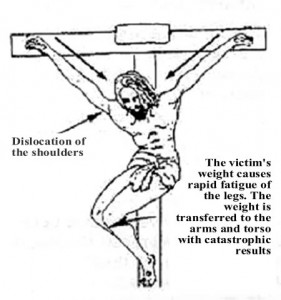Last night a few dozen of us gathered for the Maundy Thursday/Tenebrae service. It was as moving as any I recall here, punctuated by Thomas Moore’s beautiful musical accompaniment of the drama, Veronica’s poignant message about a sacramental life and communion at table. Thanks to all who contributed to its meaningfulness.
It seemes approrpiate that we pause to remember Christ’s suffering on this overcast day that has eough chill in the air to dampen our spirit.Yesterday, Veronica and I attended a presentation by Alan Kline, a CMC Emergency physician who has spent years researching how Christ – and anyone else who was crucified – died. It’s not for the feint-hearted, but I thought I would share some of what we learned:
As a practice, crucifixion dated to 5,000 BC. In 73 BC, 6,000 of Spatacus’ followers were crucified by his enemy as a show of intimidation.
On the night of his arrest, the night before his crucifixion, Jesus probably walked about 6 miles from Jerusalem to Gethsemene then back to Jeruslalem to the two trials he endured.
Custom dictated that before crucifixion, victims were scourged or flogged with leather straps that held sharp fragments of metal and bone. The goal was to tear and rip the flesh and muscle of the victim, who was tied to a post and flogged by two professional centurions who alternated their swings. They threw the leather straps into the flesh and yanked back sharply so as to do the most harm.
The cross-beam of the cross which Jesus carried over 1,000 feet probably weighed 75 pounds, made of rough wood that dug into his shredded shoulders and back.
Crucifixions were normally held in the afternoon, so crowds could attend. They were managed to draw crowds and keep them excited.
Jesus’ cross was most likely in the shape of a capital T and he was most likely nailed to it only about 1-2 feet off the ground. As in the illustration, the nails were put through his wrists, cutting the nerve and numbing his hand. He probably did not have the support some crosses have under his feet, so his weight rested on the spike or nail. Thus his body was twisted.
Spreading one’s arms out far makes breathing harder (try it). To catch one shallow breath, the person being crucified had to do the equivalent of a pull-up.
The process of dying took about 6 hours, in 80-degree heat, after major- to massive-blood loss, with birds and horsefly-like insects landing and picking at the body.
Several physiological reasons could explain why blood and water flowed out of Jesus’ side when he was speared: internal bleeding from the flogging or a clot might have formed, gathering blood in the lungs. (Mediteranian men are more succeptible to clotting).
Likely causes of death included shock, respertory failure, a clot flowing to the lung and cutting off blood flow to the heart, or a combination.
Up until Christ’s, crucifixion was a daily event. The practice virtually disappeared after Golgotha and was outlawed by Emporer Constantine about three centuries later. Dr. Kline concluded by saying that after years in the ER – having been faced with patients who been cut in half by a railroad train or caught in a lathe or slashed to pieces in a fight – he has never seen so violent a means of death as crucifixion.
I will post an Easter preview tomorrow. For now, let us think on what our Lord subjected himself to and remind ourselves that our God knows uncommon suffering.
Last night in our service, we sang the words to Isaac Watts’ classic “When I Survey the Wondrous Cross:”
See, from His head, His hands, His feet, sorrow and love flow mingled down; Did e’er such love and sorrow meet, or thorns compose so rich a crown.
When I survey the wondrous cross, on which the Prince of glory died; My richest gain I count but loss, and pour contempt on all my pride.
Amen

